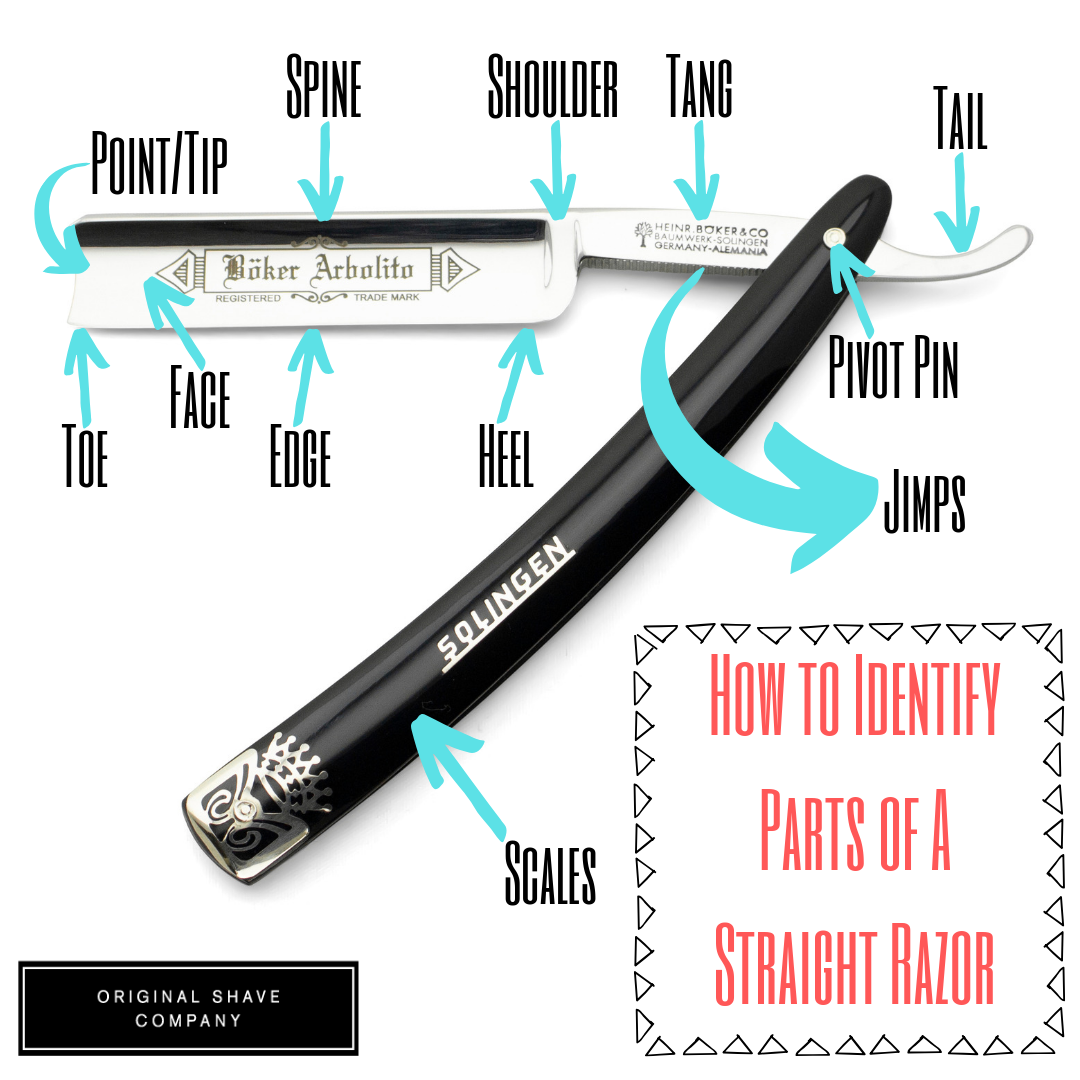
Simplicity is the name of the game when it comes to straight razors, but these classy shaving tools are more complicated than they might seem at first. Learn more about the different parts of a straight razor and how each component contributes to the perfect shave.
1. Edge
The edge is the most important part of a straight razor. It’s the component of the razor that separates your hair follicles from your face; a good straight razor edge is as sharp as possible and made from the highest-quality stainless steel. The benefit of stainless steel is that corrosion/rust is limited and not very likely under normal circumstances.
2. Face
While the edge might be the most important part of a razor for people who shave, the face is the most important part for brands. The face is the flat side of your straight razor blade. Companies, such as Boker like the example above, like to put their logos on these parts of straight razors.
3. Heel
The heel is the back end of the razor’s edge. It marks the point where the edge ends and the tang begins. Most people don’t use this section of the blade to shave but definitely can be used if desired.
4. Toe
The toe of a straight razor serves the same purpose as the heel, but it’s at the front side of the edge. People who shave with straight razors tend to use the part of the blade right next to the toe as a tool for getting rid of those pesky hairs that appear under the ears and next to the nose.
5. Point
The point of a razor is the foremost part of the blade. It generally isn’t sharp, and it’s actually usually rounded. In this example with a Spanish tip, you could use it to remove hairs as your skill level increases. People who shave with straight razors can use the points of their razors for pinpoint blade maneuvering.
6. Spine
Are you tired of all the anatomical analogies yet? You guessed it; the spine is the part of a straight razor that runs along its back or opposite of the cutting edge. The spine of a razor usually bulges out to a degree to make it easy for you to grip. This varies with different manufacturers and models.
7. Shoulder
The shoulder is the part of a straight razor where the blade and the tang meet along the spine. This straight razor component is the largest part of the spine, and it serves as an indicator of where the blade of your razor ends and the tang begins. The bulge of the shoulder makes it easier to determine where you should grip the tang while you’re shaving.
8. Tang
If you’ve ever used a machete, you might already know what a tang is. No, this part of your straight razor doesn’t have anything to do with that surprisingly bitter instant drink mix of astronaut fame. Rather, it’s the part of your razor you grip while you’re shaving to make sure you get the closest and safest shave possible.
The tang extends from the shoulder of the razor all the way down to the pivot pin. In fact, this part of a straight razor continues past the pivot pin to end in a small tail.
The tang on a straight razor is usually about as long as the blade, and it’s made from thick steel you can grip carefully to give yourself a precise shave.
9. Jimps
Not all straight razors have jimps, but those that do are usually more stable and easier to use. These recessed, textured features provide friction at the point where your thumb and index finger hold your straight razor. These razor features first came into existence in the 1800s, and while some men might prefer the feeling of raw steel under their fingertips, razors with jimps provide a cleaner grip and enhanced control during the shaving process. In the example above, you could clearly see the jimps which will provide that extra comfort and grip when shaving cream and water is being used.
10. Tail
The tail of your straight razor is the part of the tang that sticks out beyond the pivot point. You can put your thumb on the tail while the razor is closed to open it, and this component is one of the most important parts of your straight razor even though it might seem useless at first glance; the tail provides a counterweight to the blade of the razor to make sure your shaving tool is perfectly balanced.
11. Pivot Pin
The pivot pin is the part of your razor that allows you to open or close your shaving implement. It’s not enough for a pivot pin to allow you to open your razor whenever you need it; this component must also be just tight enough to keep your razor steady while you shave.
12. Scales
Every straight razor handle is unique. Some straight razors might have spirals on their handles, or others might have stripes. Whichever pattern you find on your razor handle, you’ll notice that this part of your shaving tool is textured to give you a better grip.